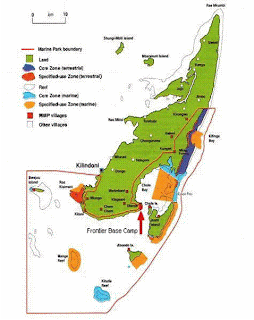
Brought to the spotlight in recent years, are the environmental concerns over the use of limited resources such as petrochemical sources, coal and natural gas. Doubled with the rising price of crude oil, the potential for the production of bio-fuels has gained increased interest worldwide (Abdullah et al., 2009; Koh & Ghazoul, 2008; Koh, 2007; Tan et al., 2007; Zhou & Thomson, 2009). As it stands, bio-fuels still only represent a small proportion of total fuel consumption in the world, but their share is expected to grow exponentially over the next few years (Fitzherbert et al, 2008; Koh, 2007; Zhou & Thomson, 2009). Currently, rapeseed oil accounts for more than 80% of the world bio-diesel productions. However, given that the cost of palm oil is at least $200 US dollars per tonne cheaper than rapeseed oil indicates that palm oil will, without doubt, become a more attractive candidate as a source of bio-diesel compared to other vegetable oils (Tan et al, 2007).
Oil palm (Elaeis guineensis) is grown in 43 countries worldwide with a total cultivated area accounting for nearly one-tenth of the world’s permanent cropland (Figure 1; Koh & Wilcove, 2008). The two largest oil palm producing countries – Indonesia (4.1 million ha) and Malaysia (3.6 million ha) are both located in South East Asia. Not only are they the largest producers of oil palm, but between them are home to 11% of the world’s remaining tropical forests (Koh & Wilcove, 2008).
The expansion of oil palm cultivation poses a significant threat to ecosystems, biodiversity and potentially, the global climate if not managed correctly (Koh et al, 2009). Accepting that there is the potential for many individual plant and animal species to be adversely affected by biodiversity loss and, dependent on region, there may be fewer or greater endemic or rare species. Also in ecological terms, there may well be much we don’t yet know or fully understand about the effects of oil palm production. My report aims to broadly identify the potential impacts on biodiversity from oil palm production and to highlight how biodiversity loss and plantation effects might further impact forest hydrological processes. The report also aims to discuss some of the benefits of oil palm production and to deliver some possible methods for responsible cultivation.
Most evidence on this subject seems to label the oil palm industry as anthropocentric and unsustainable, much like the oil industry. But it is easy to forget that palm oil provides nearly 30% of the world’s edible vegetable oil, and has been a major force for poverty alleviation and rural development worldwide (Corley, 2008).
As well as some socio-economic benefits, oil palm cultivation could have the potential to enhance soils in several ways. On lands which have been degraded by fires, erosion and salinization, planting oil palms could help to restore soil fertility and structure (Phalan, 2009). Furthermore, recent studies have shown that oil palm plantations may be more effective than rainforests in serving as ‘carbon sinks’, absorbing harmful gases like carbon dioxide (Tan et al, 2007). This is contrary to the claims by NGOs that oil palm plantation is bad for the carbon cycle in the atmosphere compared to virgin rainforest (Tan et al, 2007). The actual net assimilation of carbon dioxide for oil palm plantation compared to rainforest is 46.5 and 42.2 tonnes of C02 per hectare per year respectively (Tan et al, 2007).
Undoubtedly, there are many benefits to the production of oil palm, but evidence clearly hangs in the favour of minimising the ecological affects oil palm cultivation. The ecological impact of oil palm depends crucially on the extent to which it is able to support biodiversity, and on the extent to which its expansion causes deforestation (Fitzherbert et al, 2008).
For the industry to progress sustainably there is a need to create an adaptive management framework for strategic assessment, not just in regards to the environmental impacts of oil palm cultivation, but also of the social and economic impacts. A framework could be used as a guide for identification of appropriate locations and scale for oil palm development that will minimise negative impacts.
With regards to biology, oil palm plantations are clearly a poor substitute for native tropical forests. Evidence gathered reveals that they support fewer species of conservation importance, and effect biodiversity in adjacent habitats through fragmentation, edge effects and pollution.
Comparative studies on the hydrological effects of eucalyptus and pine plantations revealed that even after 3 years of establishment, runoff was still a major problem and thought to be a direct result of forestry management techniques. However, there are no studies to suggest that these trends would continue over a longer period, and also the assumption that these trends are like for like with oil palm plantations is purely speculative and cannot be considered accurate. Further research would be required to prove this theory.
Looking at the increase in oil palm development on peatland, it is conclusive that the effects of draining these wetlands prior to cultivation, does indeed impact the environment through the release of C0¬2. However, the fact that oil palm plantations are more effective than rainforests in serving as ‘carbon sink’ does pose the question of whether oil palm development might counteract the effects of degrading the peatland environment. Again, there has been no comparison of C0¬¬2 sequestion in oil palm plantations to peatland. Perhaps this would be another area for further research.
In conclusion, unless governments in producer countries become better at controlling oil palm development, ensuring that crops are planted only in appropriate areas, the impacts of oil palm expansion on biodiversity and hydrology can expected to be substantial.

